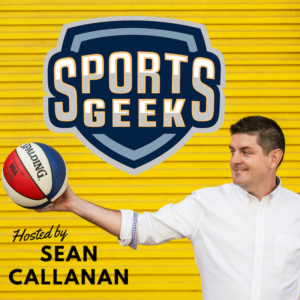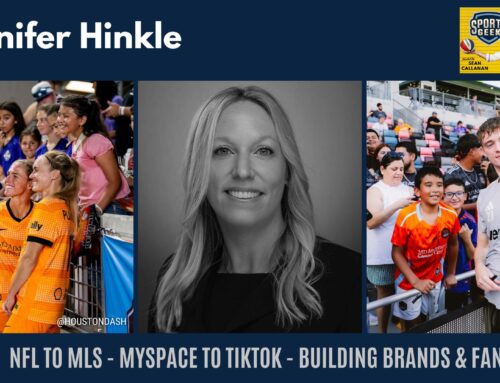In this episode of Sports Geek, Sean outlines how we use AI & Automation at Sports Geek.
On this podcast, you'll learn about:
- Why we needed to reimagine our content curation process
- Why my geek skills (coding) have been handy even using no-code tools
- How we built Sports Geek Reads
- Using Make.com to automate content and curation tasks
- What we've learned using different AI models like ChatGPT and Claude
- How we built Sports Geek Rapid Rundown with a cloned voice
- How you can leverage these tools to deliver for your fans

Sean Callanan on AI & Automation tools we use at Sports Geek
Can't see podcast player? Click here to listen
How We're Using AI and Automation at Sports Geek
Before I founded Sports Geek, I spent 15 years running development teams and working in IT. That technical background has proven invaluable as we explore how artificial intelligence and automation can revolutionise our content creation process and help Sports Geek clients do the same.
In this post, I want to pull back the curtain and show you exactly how we use these tools at Sports Geek and what we've been building.
Why We Needed a New Approach
Let me start with our challenge: our content curation system for Sports Geek News was failing. It relied heavily on Twitter (now X) to source sports business (aka #sportsbiz) content, using engagement metrics to determine what to include in our newsletter.
But platform changes (hello Elon) and shifting user behaviours meant the approach wasn't working anymore. Additionally, with the boom in email newsletters, valuable content was increasingly spread across different channels.
We needed a new system.
That led us down an exciting path of exploration of how we could use AI and automation tools to build something we needed.
Building Our New Content Curation Engine
We tackled this in three phases, each building on the success of the previous one.
Phase 1: Getting the Content Collection Right
First, we needed to solve the content-sourcing problem.
We built a system using the following tools/tech stack:
- Make.com for workflow automation
- OpenAI (ChatGPT) and Anthropic (Claude) for analyzing and finding relevant links
- Airtable as our database backend to save our links with our ratings
- Raindrop.io for manual bookmarking
With every Make scenario, the key was getting these tools to work together.
Now, we have workflows that run at 5 AM every morning, checking through emails, searching the web for links, and rating each link based on our criteria.
Phase 2: Making Content Accessible
Curation has been our strength over the past 15 years, amplifying articles and knowledge across our social media channels and email newsletter.
Once we had the links flowing internally for our team, we wanted to offer a way to share it with the Sports Geek audience.
That's where we started to build Sports Geek Reads.
I hadn't coded in 15 years, but with pair-programming help from Claude AI and using Replit, we built a Reddit-style interface where users can:
- Access a comprehensive archive of sports business content curated by our rating system
- Filter content by tags
- Vote on articles
- Sort by trending and latest
- Submit articles of interest
Phase 3: Creating an AI-Powered Podcast
This was always our end goal – creating an automated daily podcast – Sports Geek Rapid Rundown.
Fun fact: ChatGPT actually came up with that name!
Here's how it works:
- A Make scenario will build a Daily Reads blog post of the latest articles we have identified.
- We manually check (for now) the blog post for any issues and hit publish.
- Once published, Claude will write a podcast script.
- Eleven Labs creates the audio using my cloned voice after we loaded a few hours of my audio recordings.
- Auphonic handles publishing to Libsyn (our podcast hosting service)
The process of building Rapid Rundown has been fun and has our whole team thinking of ways they can leverage these tools further.
What This Means for the Sports Industry
Here's where I get excited about the possibilities. Think about:
- Serving Your Older Fans: What if you could send a daily email recap with all your team's news, media mentions, and best social media content? It's perfect for fans who aren't active on social media but regularly check their email. Plus, it creates new sponsorship inventory.
- Voice Technology: Imagine sending personalized audio messages to fans in the voice of their favourite players (with appropriate approvals). This could be the next frontier of name, image, and likeness rights.
- Content Production We've already built tools that help our team create content faster. What used to take 45-60 minutes now takes 15 minutes. These micro-savings add up quickly.
How to Get Started
When I talk to the sports industry about implementing AI, I always look at three areas:
- Time Savings – What repetitive tasks are your team doing that could be automated? Start there. Automate the Often
- Revenue Impact – How can you create more content without adding headcount? Where are the new sponsorship opportunities? High-value, low-touch assets
- Resources – Start small, with help (let's chat). As you build confidence, you can automate more.
Looking Forward
I've always focused on learning new tools and tech – it's part of Sports Geek's DNA.
What excites me most about AI is how it's unlocking possibilities that were previously constrained by resources.
Ideas that once seemed impractical due to time or staffing limitations are now achievable.
We're still learning and experimenting every day.
But that's part of the journey, and the results we're seeing make it worth the effort.
Want to explore how you can use AI in your sports organization?
I'd love to chat. You can book a call here.







